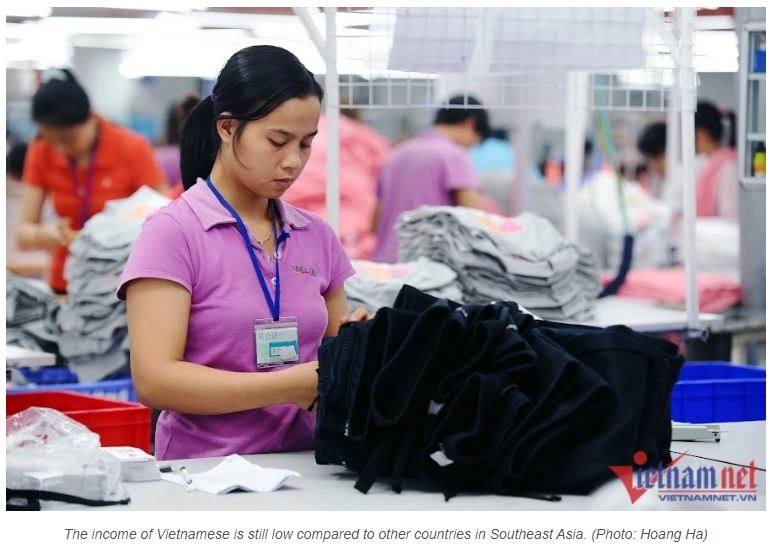A ‘miracle’ for Vietnam to catch up with Thailand and Malaysia
VietNamNet’s recent article “Income per capita in 2030 expected to be equal to Malaysia in 2007” has attracted many comments from readers.
In addition to pessimistic opinions about the growth of the economy, many readers are also optimistic about the future.
An overseas reader shared his views: In 2007, according to the International Monetary Fund (IMF), Vietnam’s GDP per capita was nearly 900 USD; Malaysia 7,400 USD; Indonesia and Philippines nearly 2,000 USD; Thailand about 4,000 USD; Laos and Cambodia was similar to or a little higher than Vietnam’s.
In 2022, according to IMF’s forecast, Vietnam’s GDP per capita will be about 4,200 USD – higher than that of the Philippines ($3,500), almost equal to Indonesia while that of Thailand will be 7,300 USD and over 10,000 USD for Malaysia.
“In fact, although there are many limitations and difficulties, Vietnam has shortened the development gap and is accelerating, especially in the last six to seven years. In addition, many international organizations believe that Vietnam will be an economic tiger and a major production center of the region if it actively reforms… We should not be complacent, but need to try and reform more strongly, but also should not be too pessimistic,” the reader commented.
Since Vietnam opened its doors, especially in the period 1991-2007, Vietnam’s economy has transformed to become a bright spot in the region, gradually narrowing the gap with other countries.
However, the problem Vietnam is facing is that its growth is slowing down. In 1991-2000, the country’s average GDP growth reached 7.56%, with 9.5% as the highest in 1995. In the 2001-2010 period, the average growth rate was 7.26%, with 8.7% as the highest rate in 2005. But in the next period of 2011-2020, the average growth was only 5.95%, with 7.08% the highest level in 2018.
The Ministry of Planning and Investment is worried: “The risk that Vietnam will lag further in productivity than other countries in the region, even falling into the middle-income trap, is high.”
The slowdown in GDP growth as well as per capita GDP growth for many years of some countries in the region such as Malaysia and the Philippines is a warning for Vietnam.
Regarding the decline in Vietnam’s GDP growth rate, Dr. Tran Dinh Thien, former Director of the Vietnam Institute of Economics, said the trend of decreasing GDP growth rate is “solid” because it has lasted for three decades.
Japan, South Korea, Taiwan (China) or, more recently, the Chinese economy, have all achieved and maintained high growth rates lasting for more than three decades, even when the economy reached large scale, far beyond the current economic scale of Vietnam.
According to Dr. Thien, the “problematic” situation of development stems from the fact that the development drivers of the economy are not promoted or even reduced. That is the root of the “developmental lag” that is difficult to overcome.
“The goal of ‘escape from the middle income trap’ is very difficult”, wrote Dr. Dang Kim Son, former director of the Institute of Policy and Strategy for Agriculture and Rural Development, in a research report sent to the Central Economic Commission.
According to Dr. Son, Asian economies that have overcome the middle-income trap must raise GDP growth rates to 8.2-10.5%/year for 5-9 consecutive years. It is more difficult for Vietnam because its growth rate is much lower. Clearly, the old growth model that has persisted until now does not allow the Vietnamese economy to make the necessary breakthrough to overcome the middle-income trap.
The research by Dr. Son pointed out a huge challenge for Vietnam. With an average GDP per capita growth of 7% or more, Vietnam can catch up with average countries in Southeast Asia such as Thailand or Malaysia. In order to catch up with China, Vietnam must grow at 10.48%, and to be on par with South Korea, it must achieve a growth rate of 11.08% in the next 30 years.
Such “miracles” have been accomplished by several countries such as South Korea, which had an economic growth rate of 9.3%/year for 38 consecutive years (1960-1997); China with 9.8%/year for 37 consecutive years (1978-2014), including 15 consecutive years with a growth rate of over 10%. Israel achieved a yearly growth rate of over 10% for 22 consecutive years (1950-1972).
To overcome the middle-income trap, the solutions proposed by Dr. Thien include: developing all types of markets, paying special attention to the development of input resource markets, particularly the land market, which is the most important content to create motivation for the development of the economy in the coming period.
In addition, it is necessary to build a state for development in the spirit of serving the market, serving businesses, with a modern development governance institution that is consistent with integration commitments; and adhere to the principle of “internal resources are decisive, external resources are important” in developing Vietnam’s business force and implementing strategies to attract FDI.
Luong Bang
Source: https://vietnamnet.vn/en/a-miracle-for-vietnam-to-catch-up-with-thailand-and-malaysia-2051275.html


 Thailand
Thailand




